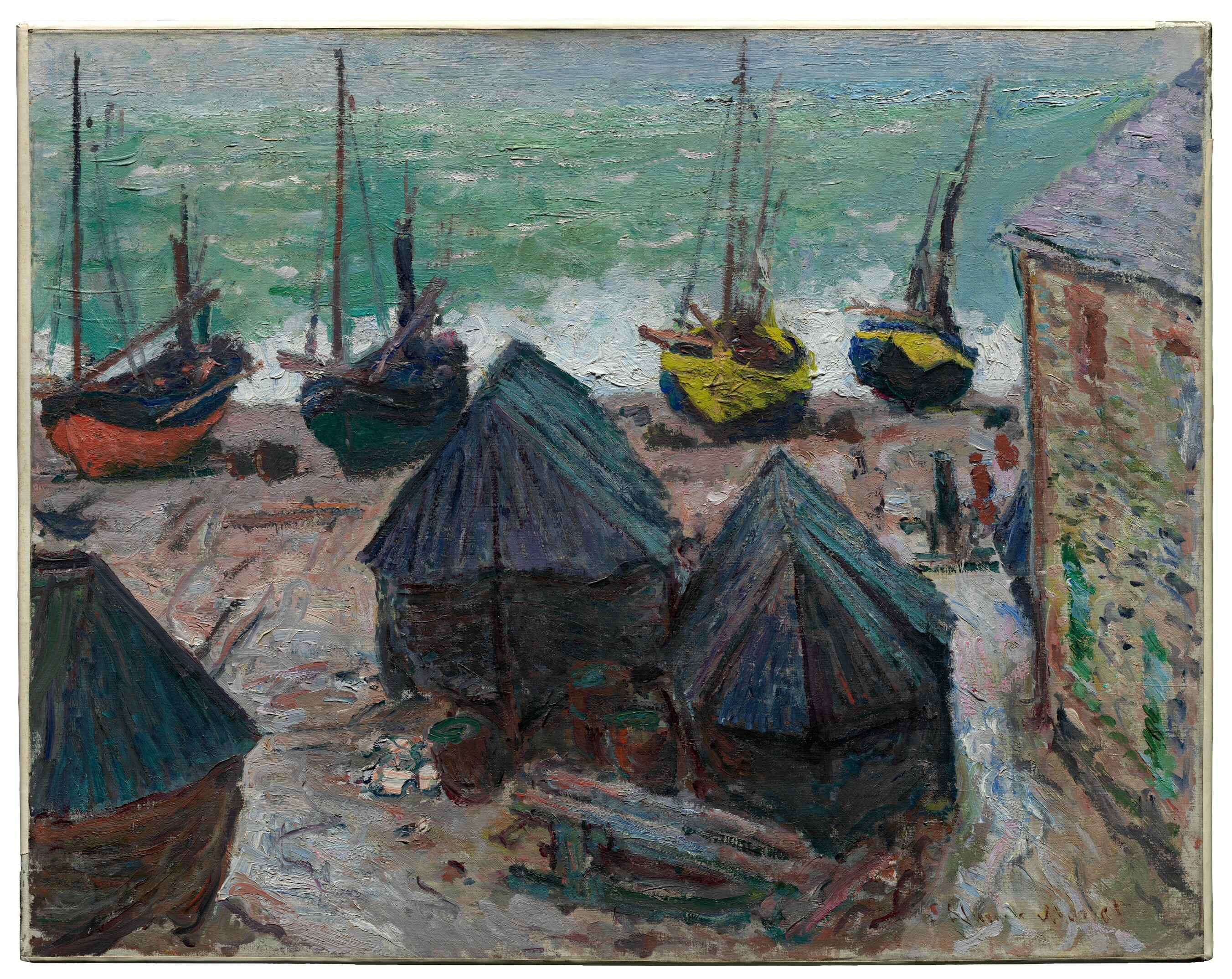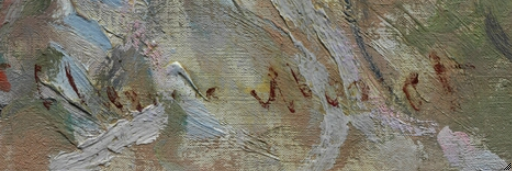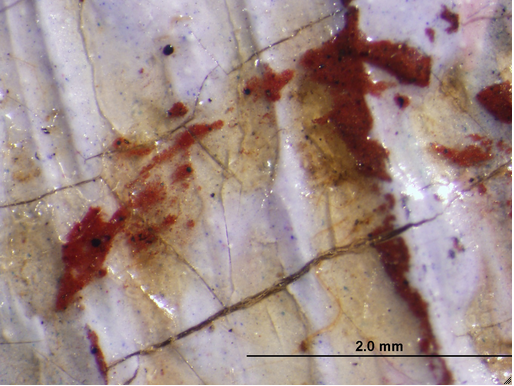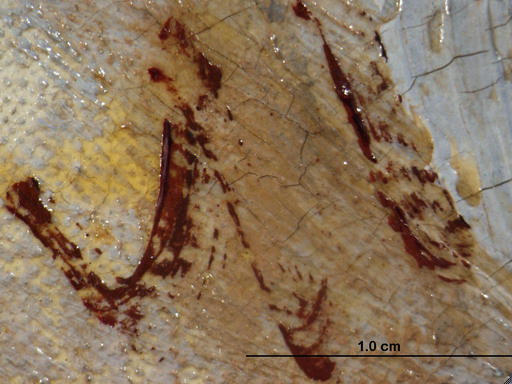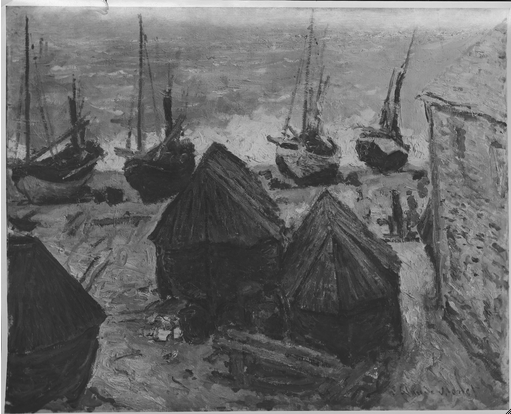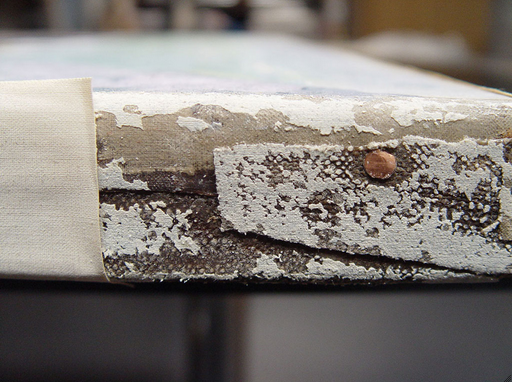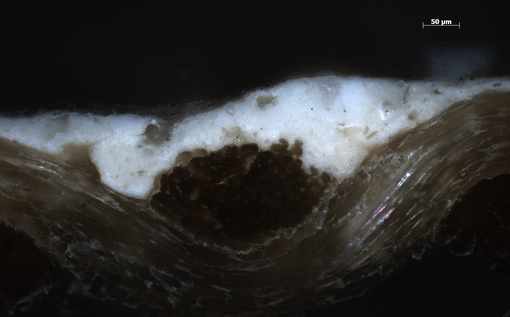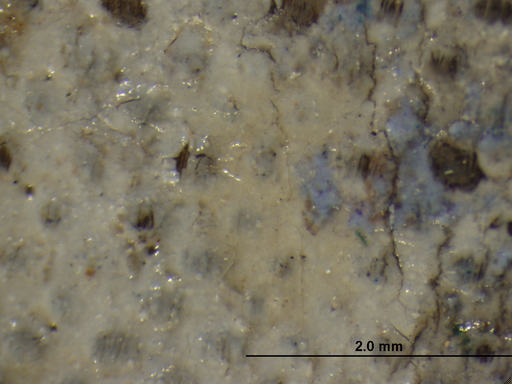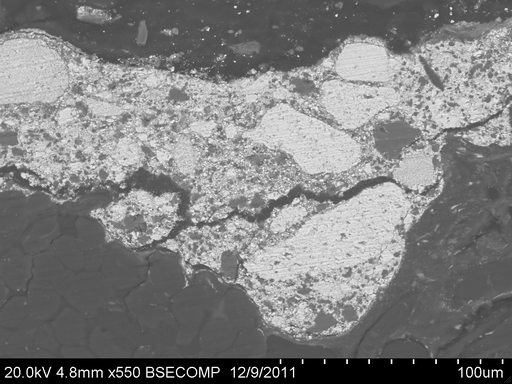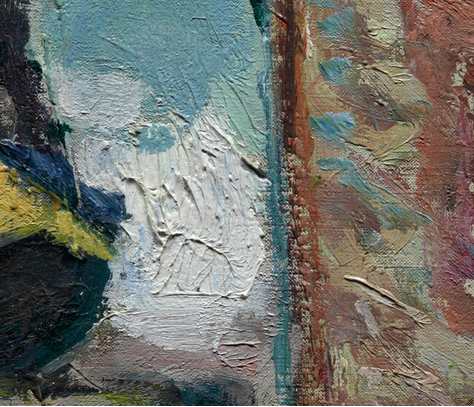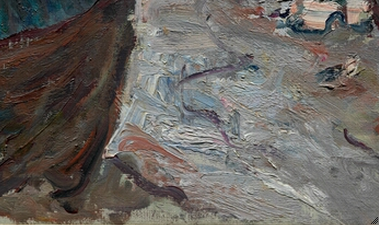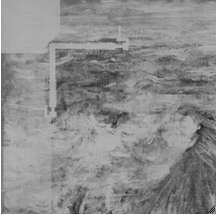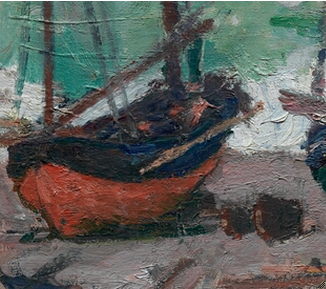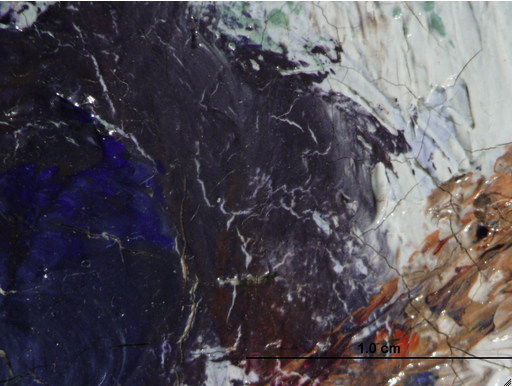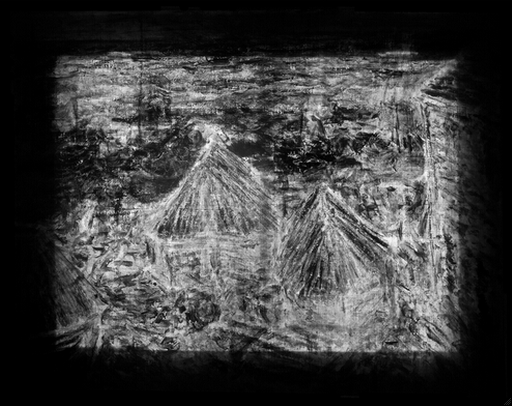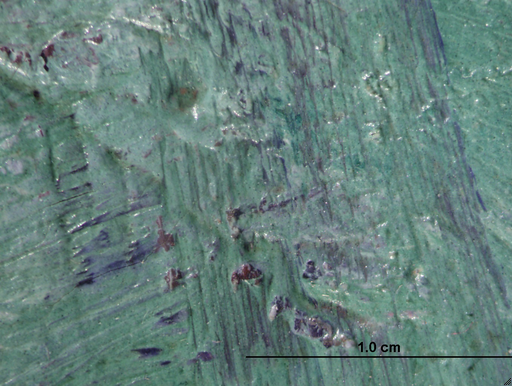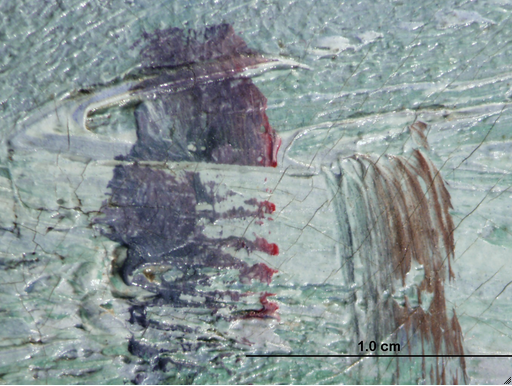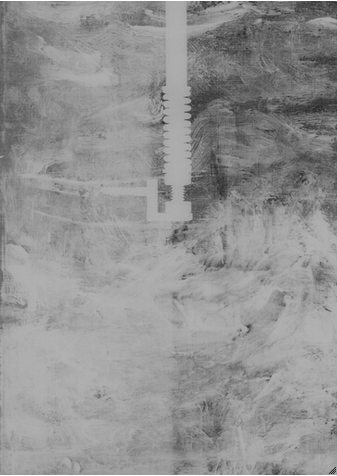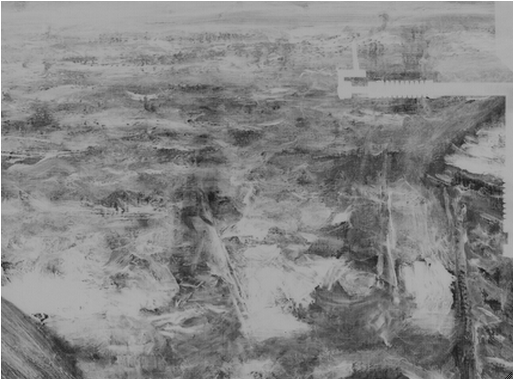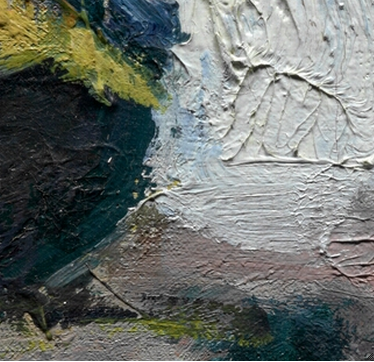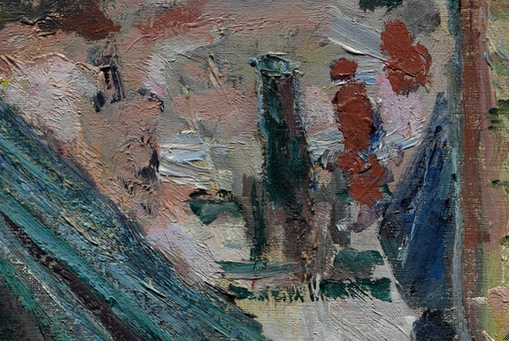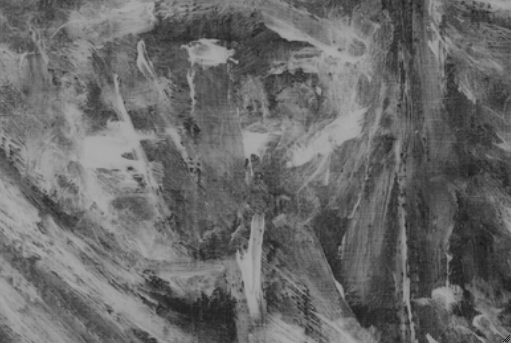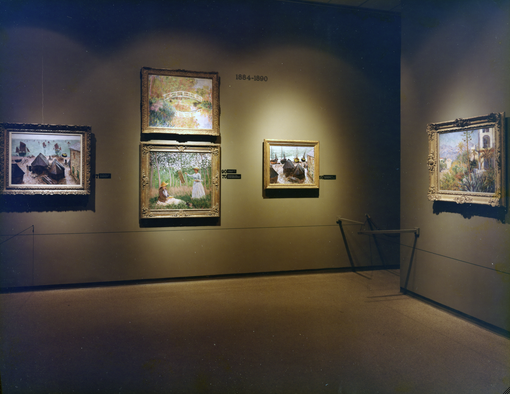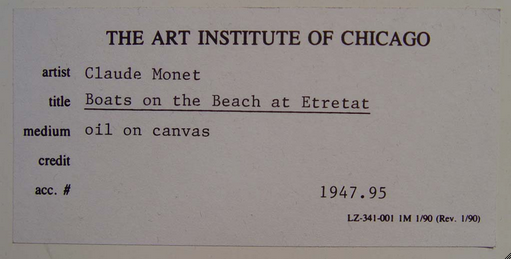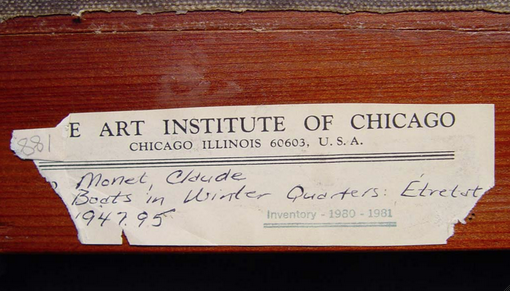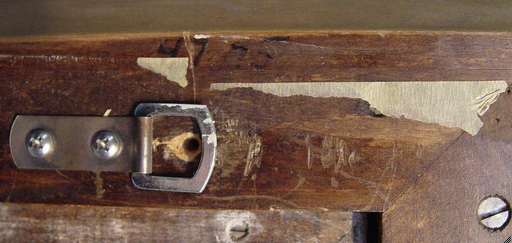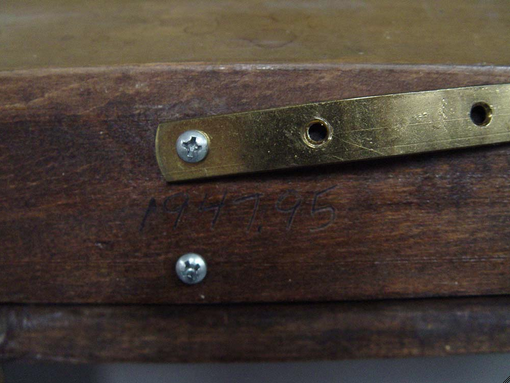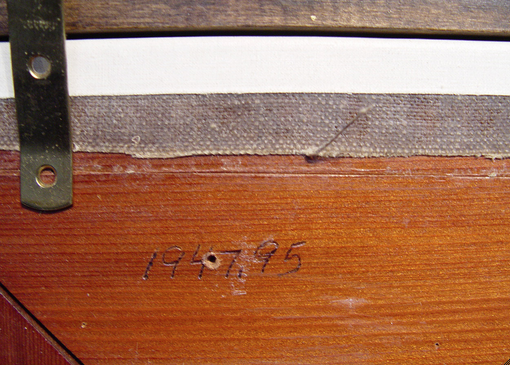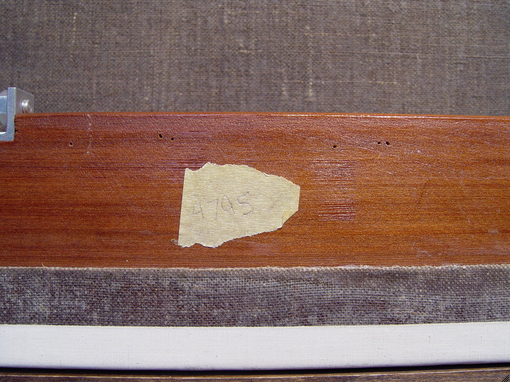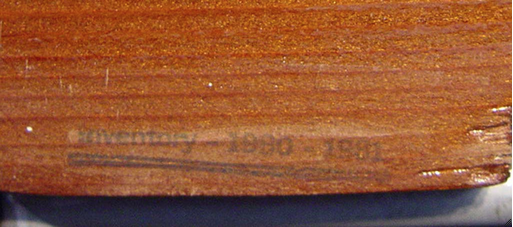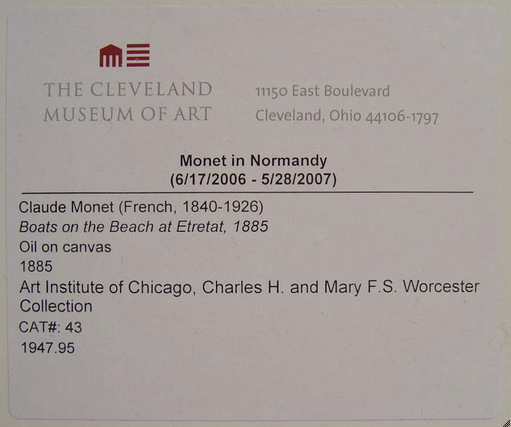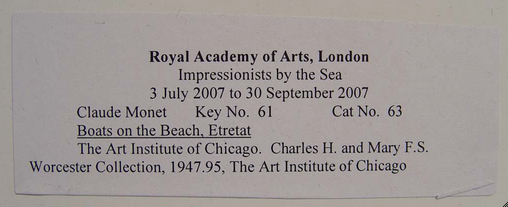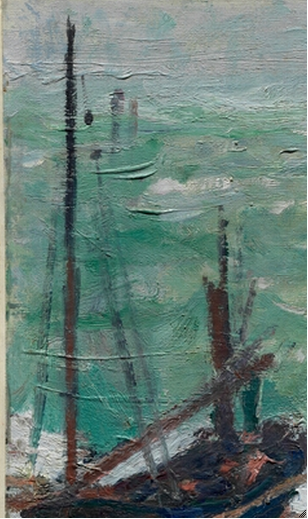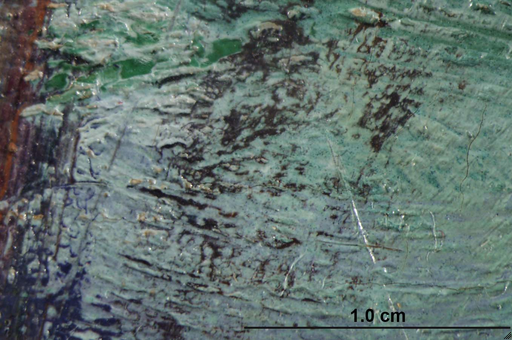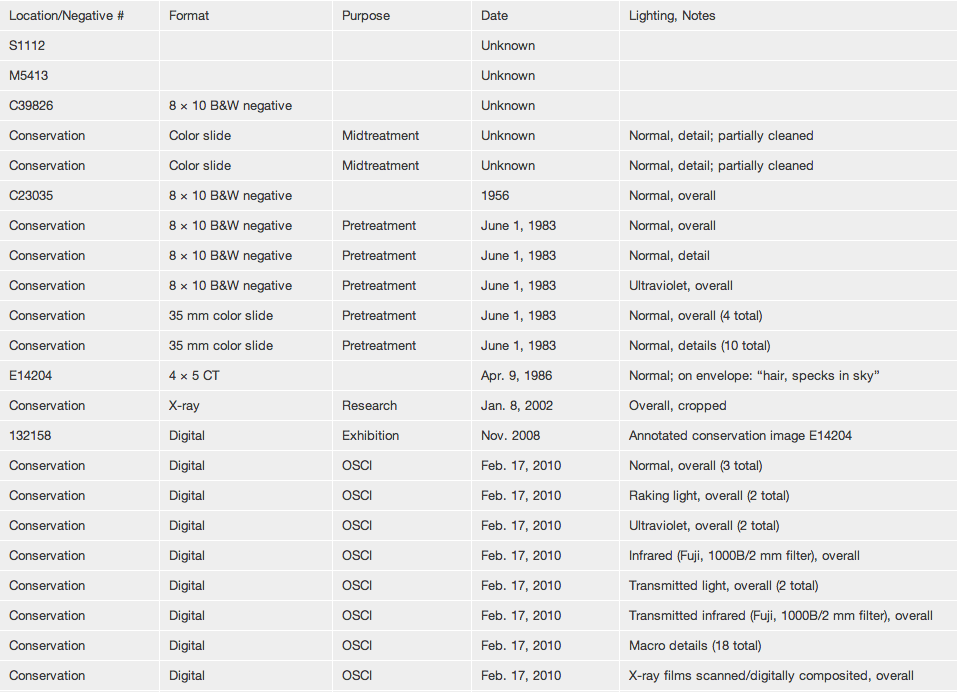Technical Report
Technical Summary
Claude Monet’s Boats on the Beach at Étretat was painted on a [glossary:pre-primed], no. 25 portrait ([glossary:figure]) standard-size linen [glossary:canvas]. The [glossary:ground] is off-white and consists of a single layer. There is a stamp from the [glossary:color merchant] Vieille & Troisgros on the back of the original canvas. The work is largely composed of a thick buildup of vigorous brushwork, some of which is related to changes made to the composition in the painting process. The stone building and the caloges were planned from early on and are painted directly over the ground layer; however, major revisions were made to the fishing boats on the beach. It appears that the two boats on the left side were originally painted into the composition and then covered by the water; the boats seen in the final painting were added, mostly [glossary:wet-in-wet], over the thick lead white–rich paint of the waves. It seems that the artist wiped or scraped away some of the earlier paint, but traces of the rigging from the first boats remain visible. The two right-hand boats were incorporated into the composition early on; waves were subsequently painted over a significant portion of the left side of each boat, with elements of the final boats painted on top of the water. Some more-intense colors, which seem to be related to the earlier boats, are visible on the surface through breaks in the brushwork. A second winch may have originally been included to the left of the existing winch on the midright side of the painting, and a second figure was added later in the same area. Some slight adjustments were made to the position of the barrels in the foreground. The signature was applied after the painting had already been varnished.
Multilayer Interactive Image Viewer
The multilayer interactive image viewer is designed to facilitate the viewer’s exploration and comparison of the technical images (fig. 22.1).
Signature
Signature/Stamp
Signed: Claude Monet (lower right corner, in red-brown paint) (fig. 22.2). The underlying paint layers were dry when the signature was applied. In addition, in some areas, the signature appears to lie on top of remnants of yellowed [glossary:varnish] (fig. 22.3) and to bridge cracks formed in the underlying paint layer (fig. 22.4). This indicates that the signature was applied after some cracks had already formed in the painting and after the painting had been varnished. Compared with an archival black-and-white photograph (dated 1922) (fig. 22.5), it appears that some of the signature paint may have been removed in a previous cleaning (see Conservation History).
Structure and Technique
Support
Canvas
Flax (commonly known as linen).
Standard format
The original dimensions were approximately 65 × 81.5 cm. This corresponds closely to a no. 25 portrait (figure) standard-size canvas (81 × 65 cm), turned horizontally.
Weave
[glossary:Plain weave]. Average [glossary:thread count] (standard deviation): 26.8H (0.8) × 28.8V (0.7) threads/cm. The vertical threads were determined to correspond to the [glossary:warp] and the horizontal threads to the [glossary:weft]. No [glossary:weave match] was found with other Monet paintings analyzed for this project.
Canvas characteristics
There is moderate, relatively even [glossary:cusping] on the top, bottom, and left edges. The cusping is slightly more pronounced and irregular along the right edge.
Stretching
Current stretching: Dates to 1962 conservation treatment (see Conservation History). The canvas is attached with copper tacks spaced approximately 6–8 cm apart.
Original stretching: It was not possible to observe all of the original [glossary:tacking edges] because of fabric strips adhered to the edges on all sides.
Stretcher/strainer
Current stretcher: Four-membered [glossary:ICA spring stretcher]. Depth: 3.5 cm.
Original stretcher: Discarded. The pre-1962-treatment [glossary:stretcher] may have been the original stretcher. The 1962 examination report states that the previous stretcher was five membered, including a vertical [glossary:crossbar], with mortised joints and [glossary:keys]. Depth: Not documented.
Manufacturer’s/supplier’s marks
A supplier’s stamp on the original canvas back was transcribed before the painting was lined in 1962 (see Conservation History) (text within palette-shaped frame): H. VIELLE [sic] E TROISGROS S[. . .] / 35 RUE RAVEL [sic] [. . .] / PARIS / COULEURS FINES / TOILES PANNEAUX(fig. 22.6)
Preparatory Layers
Sizing
Not determined (probably glue).
Ground application/texture
There is a single, relatively thin ground layer that extends to the edges of the top, bottom, and left sides but appears to stop approximately 0.4 cm short of the right edge (fig. 22.7). This indicates that the canvas was cut from a larger roll of primed fabric on three sides; the right edge probably corresponds to the original edge of the roll that was attached to the priming frame. The canvas was probably commercially prepared. The ground ranges from approximately 20 to 125 µm in thickness (fig. 22.8).
Color
Off-white; under magnification, some dark particles were visible (fig. 22.9).
Materials/composition
Analysis indicates that the ground contains primarily lead white and calcium carbonate (chalk), with traces of bone black, iron oxide with associated silicates, alumina, aluminum silicate, and silica. Both the lead white and the chalk exhibit particles and clusters of various sizes (fig. 22.10). Binder: [glossary:Oil] (estimated).
Compositional Planning/Underdrawing/Painted Sketch
Extent/character
No underdrawing was observed with [glossary:infrared reflectography] (IRR) or microscopic examination.
Paint Layer
Application/technique and artist’s revisions
The work was densely painted with thick, vigorous brushwork, particularly throughout the water and the beach. The paint surface, with its rough brushwork and rather cursory treatment of forms, would perhaps seem to suggest a rapid execution, but the work was, in fact, carried out in multiple sessions and involved several revisions to the composition as the work progressed. Small areas of exposed ground are visible in places, for example, in between the individual strokes of the stone wall on the right and along the edges of some of the other compositional forms (fig. 22.11); but, on the whole, the work consists of thick, relatively continuous paint, making it difficult to observe the earliest layers and the precise sequence of painting. The presence of brushwork unrelated to the final composition and small glimpses of anomalous colors below the surface, as well as the appearance of the work in the [glossary:X-ray], however, indicate that the painting was heavily worked up and significantly revised in areas.
The stone building and caloges were planned from early on, laid in directly on top of the ground layer, and executed largely wet-in-wet with no evidence of any major modifications (fig. 22.12). Significant changes, however, were made to the beached boats in the middle ground. The heaviest reworking involved the two boats on the left side of the composition. These boats appear to have been included in the painting from early on; they were subsequently covered, however, by the thick paint of the water and the beach. In the final painting, the two boats were added on top, seemingly in a similar position to the earlier painting (fig. 22.13). Magnified views of the two boats on the left show that, for the most part, they were painted on top of the waves when the waves were still wet (fig. 22.14). Because of the density of the paint in this area, it is difficult to ascertain much about the earlier painting of the boats. Open [glossary:drying cracks] in the dark-purple paint of the boat on the far left, for example, reveal only the pale-blue paint from the intermediate layer of water underneath (fig. 22.15). However, the transmitted infrared image seems to suggest that both boats were originally somewhat larger or were pulled up further on the shore (fig. 22.16). In addition, traces of the rigging of both boats from the earlier painting stage remain visible to the unaided eye, positioned, in both cases, just to the right of the masts of the boats as painted in the final composition. There is evidence that the artist scraped or wiped away some of the soft paint of the earlier layers, resulting in a relatively smooth, flat paint surface (fig. 22.17). In these areas, only traces of the individual strokes related to the rigging remain. Some subsequent brushstrokes from the water partially cover the earlier rigging—microscopic glimpses through breaks in the water often reveal the more colorful paint layers beneath (fig. 22.18)—but it seems like traces of the earlier painting would have always remained visible upon close observation and that the artist was not overly concerned with concealing every trace of the earlier painting. In this area of the painting, in both the final composition and the earlier layers, it seems that there was a considerable amount of working back and forth between the boats and the water. For example, near the upper-left corner, just to the right of the upper portion of the main mast of the red boat, among the two roughly parallel fragments from the earlier rigging, the vertical stroke on the right was applied wet-in-wet into the water, whereas the stroke on the left was painted when the water was already dry (fig. 22.19). Similarly, single strokes from the final rigging were drawn through both wet and dry areas of paint from the water (fig. 22.20), indicating that, even within a fairly localized area, some strokes of the water were already dry while others were freshly applied when the rigging was added. There are some strong horizontal ridges near the left edge, visible in the X-ray and [glossary:raking light] image, which may also be related to the earlier composition (possibly an earlier position of the left boat or the initial [glossary:lay-in] of the water) (fig. 22.21). It is difficult to characterize precisely what changes were made in this part of the painting, but it seems that the two boats on the left were incorporated into the composition early on. They were then obliterated by a combination of scraping or wiping and painting the waves on top, before the final boats were executed.
Similar observations were made about the two boats on the right side of the composition, including brushstrokes unrelated to the final composition and the partial removal of the initial rigging. The X-ray indicates that these boats were incorporated early on, based on their relative radio-transparency; they too were painted over, in areas, however, with thick, white paint from the waves, mainly along the left side of each boat (fig. 22.22). Paint colors, seemingly unrelated to the final composition, are visible through breaks in the upper paint layers. Bright-yellow paint, visually similar to that used for the final yellow band of the boat farthest to the right, is visible from underlying layers around the base of this boat (fig. 22.23), and in the area of the beach between the two boats. Further down in the beach, dark-brown and purple paint is visible through breaks in the upper paint layers (around the winch), possibly indicating features unrelated to the surface composition (fig. 22.24). It seems that originally a second winch might have been included just to the left of the winch in the final painting. This was then roughly painted over when the earlier paint was dry (fig. 22.25).
Other more minor modifications include the addition of a second figure between the winch and the stone building (fig. 22.24). The rust-colored paint used in this area to define what could be two figures was applied when the underlying paint was already dry; the left figure was laid in earlier, however, with strokes of deep-red and deep-blue paint. The placement of the barrels in the foreground between the two caloges was also changed slightly (fig. 22.26).
Painting tools
Brushes, including 0.5, 1.0 and 1.5 cm width, flat ferrule (based on width and shape of brushstrokes). Several brush hairs are embedded in the paint surface.
Palette
Analysis indicates the presence of the following [glossary:pigments]: lead white, cadmium yellow, vermilion, red lake, viridian, emerald green, cobalt blue, and ultramarine blue. [glossary:UV fluorescence] indicates that red lake was used throughout the painting.
Binding media
Oil (estimated).
Surface Finish
Varnish layer/media
A spray coat of polyvinyl acetate (PVA) AYAA was applied in 1962 (see Conservation History). The surface coating is evenly applied and appears slightly glossy in some passages. Residues of an older, yellowed, [glossary:natural-resin varnish] are visible in the recesses of the paint texture. It is not known when the natural-resin varnish was applied but it was documented as being extremely discolored in 1957.
Conservation History
In 1962, discolored varnish was removed. The canvas was wax-resin lined and stretched on a new ICA spring stretcher. A spray coat of polyvinyl acetate (PVA) AYAA was applied. [glossary:Inpainting] was carried out.
Condition Summary
The painting is in good condition. The canvas is wax-resin lined and stretched taut on an ICA spring stretcher. The paint and ground layers are secure. There is some flattened paint and depressions made near the edges when the paint was still soft, which are possibly related to framing or transport of the work early on. There is also some minor abrasion and mild gouges or scratches around the edges of the painting in the frame rebate area. There are several brush hairs embedded in the paint surface. There is a general network of fine cracks, with more pronounced cracking visible in the thicker, lead white–rich passages. Localized areas of drying cracks are also present, for example, in the darker paint layers of the boats. Under magnification, residues of old [glossary:retouching] are visible on many of the wider-aperture drying cracks. There are yellowed [glossary:varnish] residues in the recesses of the paint texture and underneath the signature; this latter condition suggests that the painting was signed after the work was varnished. The signature appears to have been compromised in earlier cleanings. There are some cotton fibers and facing tissue residues adhered to the surface of the painting. Fabric strips have been applied to the tacking edges with a thick white adhesive or paint.
Kimberley Muir
Frame
The current frame (from at least 1975) is not original to the painting. It is an Italian, nineteenth-century, Salvator Rosa, scotia frame with applied composition ornament of acanthus leaf on the outside edge, laurel and berry above the scotia, and an acanthus-leaf-and-tongue sight molding. The frame is water gilded over yellow bole on gesso and composition. The convex top molding is burnished; all other areas are left matte. The frame retains its original glue [glossary:size]. The frame is made of poplar, with applied mitered back, front, and sight moldings on a half-lapped cassetta base. The molding, from perimeter to interior, is ogee with acanthus-leaf composition ornament; scotia side; convex face with treacle back edge; ovolo laurel-and-berry composition ornament; scotia (hollow); ogee with acanthus-leaf-and-tongue composition ornament; and originally a fillet (the fillet edge has been reduced back to the edge of the applied ornament). The independent fillet liner with cove sight is a later addition (fig. 22.27).
Kirk Vuillemot
Provenance
Acquired from [unknown] by Georges Bernaert.
Acquired by Georges Bernheim, Paris, c. 1907.
Acquired by Marczell de Nemes, Budapest, by 1911.
Sold at the Marczell de Nemes Sale, Galerie Manzi-Joyant, Paris, June 18, 1913, lot 113, to Durand-Ruel, Paris, as an agent for an unnamed person, for 9,500 francs.
Acquired by Kleinberger Gallery, Paris, by Nov. 15, 1922.
Acquired by John Levy Galleries, Paris, by Nov. 15, 1922.
Sold by John Levy Galleries, Paris, to Charles H. Worcester, Chicago, by Nov. 15, 1922, for $2,295.
Given by Charles H. and Mary F. S. Worcester to the Art Institute of Chicago, 1947.
Exhibition History
Budapest, Szépmüvészeti Múzeum, Nemes Marcell képgyűjteményének kiállítása [Exhibition of paintings in the collection of Marcell von Nemes], 1910, no cat. no.
Munich, Königliche Ältere Pinakothek München, Sammlung des Königliche Rates Marczell von Nemes, Budapest, ausgestellten Gemälde, June–Dec. 1911, cat. 34 (ill.), as Strandbild.
Düsseldorf, Kunsthalle, Sammlung des Königliche Rates Marczell von Nemes, July–Dec. 1912, cat. 104.
Art Institute of Chicago, Exhibition of the Worcester Collection, July 24–Sept. 23, 1923, no cat.
Toledo (Ohio) Museum of Art, Paintings by French Impressionists and Post-Impressionists, Nov. 7–Dec. 12, 1937, cat. 14 (ill.).
Arts Club of Chicago, Loan Exhibition of Modern Paintings and Drawings from Private Collections in Chicago, Nov. 4–25, 1938, cat. 87.
Art Institute of Chicago, The Paintings of Claude Monet, Apr. 1–June 15, 1957, no cat. no.
City Art Museum of St. Louis, Claude Monet: A Loan Exhibition, Sept. 25–Oct. 22, 1957, cat. 62 (ill.); Minneapolis Institute of Arts, Nov. 1–Dec. 1, 1957.
Oklahoma City, Oklahoma Art Center, Inaugural Exhibition, Dec. 5, 1958–Jan. 31, 1959, cat. 138 (ill.).
Art Institute of Chicago, Paintings by Monet, Mar. 15–May 11, 1975, cat. 68 (ill.). (fig. 22.28)
Highland Park, Ill., Neison Harris, Sept. 26–Dec. 6, 1979, no cat.
Amsterdam, Van Gogh Museum, Vincent’s Choice: The Musée Imaginaire of Van Gogh, Feb. 14–June 15, 2003, cat. 129 (ill.).
Fine Arts Museums of San Francisco, Monet in Normandy, June 17–Sept. 17, 2006, cat. 43 (ill.); Raleigh, North Carolina Museum of Art, Oct. 15, 2006–Jan. 14, 2007; Cleveland Museum of Art, Feb. 18–May 20, 2007.
London, Royal Academy of Arts, Impressionists by the Sea, July 7–Sept. 30, 2007, cat. 63 (ill.); Washington, D.C., Phillips Collection, Oct. 20, 2007–Jan. 13, 2008; Hartford, Conn., Wadsworth Atheneum Museum of Art, Feb. 9–May 11, 2008.
Fort Worth, Tex., Kimbell Art Museum, The Impressionists: Master Paintings from the Art Institute of Chicago, June 29–Nov. 2, 2008, cat. 48 (ill.).
Selected References
Catalogue de la collection de M. Georges Bernaert (n.p., n.d.), no. 86 (ill.).
August L. Mayer, Katalog der aus der Sammlung des Kgl. Rates Marczell von Nemes, Budapest, ausgestellten Gemälde, with a preface by V. Tschudi, exh. cat. (F. Bruckmann, 1911), cat. 34 (ill.).
Emil Schäffer, “Neue Bücher der Kunstwissenschaft,” Kunst und Künstler 9 (1911), p. 260 (ill.).
Gabriel Mourey, “La collection Marczell de Nemes,” Les arts 138 (June 1913), p. 30.
“Liste des prix et noms des acquéreurs de la deuxième vacation de la collection Marczell de Nemes,” Le Gil Blas, June 19, 1913, p. 2.
M. B. W., “Summer Loan Exhibitions,” Bulletin of the Art Institute of Chicago 17, 6 (Sept. 1923), p. 58 (ill.).
Toledo Museum of Art, Paintings by French Impressionists and Post-Impressionists, exh. cat. (Toledo Museum of Art, 1937), cat. 14 (ill.).
Arts Club of Chicago, Loan Exhibition of Modern Paintings and Drawings from Private Collections in Chicago, exh. cat. ([Arts Club of Chicago], [1938]), cat. 87.
Daniel Catton Rich, Catalogue of the Charles H. and Mary F. S. Worcester Collection of Paintings, Sculpture and Drawings (Lakeside, 1938), pp. vi; 76, cat. 77; pl. 45.
Art Institute of Chicago, “Complete List of Works,” Bulletin of the Art Institute of Chicago 41, 5 (Sept.–Oct. 1947), p. 63.
Oscar Reuterswärd, Monet: En konstnärshistorik (Bonniers, 1948), pp. 160; 161, fig. 75; 284.
Claude Monet: A Loan Exhibition, exh. cat. (Minneapolis Society of the Fine Arts, 1957), p. 66, cat. 62 (ill.).
William C. Seitz, “Claude Monet’s View of Nature,” in Claude Monet: A Loan Exhibition, exh. cat. (Minneapolis Society of the Fine Arts, 1957), p. 25.
A. C., “Homage to Claude Monet,” Art Institute of Chicago Quarterly 51, 2 (Apr. 1, 1957), p. 23.
Art Institute of Chicago,“Catalogue,” Art Institute of Chicago Quarterly 51, 2 (Apr. 1, 1957), p. 33.
Oklahoma Art Center, Inaugural Exhibition, exh. cat. ([Oklahoma Art Center], [1958]), cat. 138 (ill.).
William C. Seitz, Claude Monet, Library of Great Painters (Abrams, 1960), pp. 32, 126–27 (ill.).
Art Institute of Chicago, Paintings in the Art Institute of Chicago: A Catalogue of the Picture Collection (Art Institute of Chicago, 1961), p. 320.
Yvon Taillandier, Monet, trans. A. P. H. Hamilton (Crown, [1963]), pp. 46, 60 (ill.), 68.
Luigina Rossi Bortolatto, L’opera completa di Claude Monet: 1870–1889, Classici dell’arte 63 (Rizzoli, 1972), pp. 16; 57, pl. 41; 106, cat. 287 (ill.); 107.
Grace Seiberling, “The Evolution of an Impressionist,” in Paintings by Monet, ed. Susan Wise, exh. cat. (Art Institute of Chicago, 1975), pp. 30, 31, 33.
Susan Wise, ed., Paintings by Monet, exh. cat. (Art Institute of Chicago, 1975), p. 125, cat. 68 (ill.).
Daniel Wildenstein, Claude Monet: Biographie et catalogue raisonné, vol. 2, Peintures, 1882–1886 (Bibliothèque des Arts, 1979), pp. 172; 173, cat. 1024 (ill.); 268, letter 628.
J. Patrice Marandel, “New Installation of Earlier Painting,” Bulletin of the Art Institute of Chicago 73, 1 (Jan.–Feb., 1979), p. 15 (ill.).
Robert Herbert, “Method and Meaning in Monet,” Art in America 67, 5 (Sept. 1979), pp. 103, fig. 15; 105.
A. M. Hammacher and Renilde Hammacher, Van Gogh: A Documentary Biography, trans. Mary Charles (Thames & Hudson, 1982), pp. 142, pl. 118; 236.
Richard R. Brettell, “Monet’s Haystacks Reconsidered,” Art Institute of Chicago Museum Studies 11, 1 (Fall 1984), pp. 7; 19, fig. 16.
John House, Monet: Nature into Art (Yale University Press, 1986), pp. 188, 189.
Richard R. Brettell, French Impressionists (Art Institute of Chicago/Abrams, 1987), pp. 78 (detail), 79, 80 (ill.), 118.
Robert L. Herbert, Impressionism: Art, Leisure, and Parisian Society (Yale University Press, 1988), pp. 299; 301; 302, pl. 311.
Francesco Arcangeli, Monet (Nuova Alfa, 1989), pp. 56; 121, fig. 47; 155.
Richard Kendall, ed., Monet by Himself: Paintings, Drawings, Pastels, Letters, trans. Bridget Strevens Romer (Macdonald Orbis, 1989), pp. 145 (ill.), 319.
Rodolphe Rapetti, Monet (Anaya/Mondadori, 1990), p. 75, pl. 52.
Karin Sagner-Düchting, Claude Monet, 1840–1926: Ein Fest für die Augen (Benedikt Taschen, 1990), pp. 140, 141 (ill.). Translated by Karen Williams as Claude Monet, 1840–1926: A Feast for the Eyes (Taschen, 2004), pp. 140, 141 (ill.).
Sophie Fourny-Dargère, Monet, Profils de l’art (Chêne, 1992), p. 154, fig. 5.
Art Institute of Chicago, Treasures of 19th- and 20th-Century Painting: The Art Institute of Chicago, with an introduction by James N. Wood (Art Institute of Chicago/Abbeville, 1993), p. 101 (ill.).
Robert L. Herbert, Monet on the Normandy Coast: Tourism and Painting, 1867–1886 (Yale University Press, 1994), back cover (ill.); pp. 103; 106, fig. 115; 107; 108; 109 (detail).
Andrew Forge, Monet, Artists in Focus (Art Institute of Chicago, 1995), pp. 35; 36; 81, pl. 10; 107.
Daniel Wildenstein, Monet, or The Triumph of Impressionism, cat. rais., vol. 1 (Taschen/Wildenstein Institute, 1996), pp. 211, 212–13 (ill.).
Daniel Wildenstein, Monet: Catalogue raisonné/Werkverzeichnis, vol. 3, Nos. 969–1595 (Taschen/Wildenstein Institute, 1996), pp. 386, cat. 1024 (ill.); 388.
Fabrizio d’Amico, “Monet e il Mediterraneo: da Bordighera ad Antibes,” in Monet: I luoghi della pittura, ed. Marco Goldin, exh. cat. (Linea d’Ombra, 2001), p. 176 (ill.).
Cornelia Homburg, “Vincent van Gogh and the Avant-Garde: Colleagues, Competitors, Friends,” in Vincent’s Choice: Van Gogh’s Musée Imaginaire, ed. Chris Stolwijk, Sjraar van Heugten, Leo Jansen, and Andreas Blühm, exh. cat. (Van Gogh Museum/Thames & Hudson, 2003), p. 114.
Chris Stolwijk, Sjraar van Heugten, Leo Jansen, and Andreas Blühm, eds., Vincent’s Choice: Van Gogh’s Musée Imaginaire, exh. cat. (Van Gogh Museum/Thames & Hudson, 2003), p. 264, pl. 129.
Sotheby’s, New York, Impressionist and Modern Art: Part One, sale cat. (Sotheby’s, May 6, 2003), p. 73, fig. 3.
Richard Brettell, “Monet and Normandy,” in Monet in Normandy, ed. Heather Lemonedes, Lynn Federle Orr, and David Steel, exh. cat. (Fine Arts Museums of San Francisco/North Carolina Museum of Art/Cleveland Museum of Art/Rizzoli, 2006), p. 48.
Heather Lemonedes, Lynn Federle Orr, and David Steel, eds., Monet in Normandy, exh. cat. (Fine Arts Museums of San Francisco/North Carolina Museum of Art/Cleveland Museum of Art/Rizzoli, 2006), pp. 136–37, cat. 43 (ill.); 185.
David M. Hopkin, “Fishermen, Tourists and Artists in the Nineteenth Century: The View from the Beach,” in John House and David M. Hopkin, Impressionists by the Sea, exh. cat. (Royal Academy of Arts, London/Thames & Hudson/Abrams, 2007), p. 33.
John House and David M. Hopkin, Impressionists by the Sea, exh. cat. (Royal Academy of Arts, London/Thames & Hudson/Abrams, 2007), pp. 113, cat. 63 (ill.); 139, cat. 63 (ill.); 140.
Eric M. Zafran, “Monet in America,” in Wildenstein and Co., Claude Monet (1840–1926): A Tribute to Daniel Wildenstein and Katia Granoff, exh. cat. (Wildenstein and Co., 2007), p. 127.
Eliza E. Rathbone, “Impressionists by the Sea,” Phillips Collection Magazine (Fall 2007), p. 5 (ill.).
Gloria Groom and Douglas Druick, with the assistance of Dorota Chudzicka and Jill Shaw, The Impressionists: Master Paintings from the Art Institute of Chicago, exh. cat. (Art Institute of Chicago/Kimbell Art Museum, 2008), pp. 17; 108, cat. 48 (ill.). Simultaneously published as Gloria Groom and Douglas Druick, with the assistance of Dorota Chudzicka and Jill Shaw, The Age of Impressionism at the Art Institute of Chicago (Art Institute of Chicago/Yale University Press, 2008), pp. 17; 108, cat. 48 (ill.).
Jennifer A. Thompson, “Van Gogh and Close-Up Techniques in 19th-Century French Painting,” in Van Gogh Up Close, ed. Cornelia Homburg, exh. cat. (National Gallery of Canada, Ottawa/Philadelphia Museum of Art/Yale University Press, 2012), pp. 69; 70, ill. 50; 94, n. 15.
Other Documentation
Documentation from the John Levy Galleries Archives
Purchase invoice
Documentation from the Bernheim-Jeune Archives
Photograph
Labels and Inscriptions
Undated
Label
Location: [glossary:backing board]
Method: printed label with typewritten script
Content: THE ART INSTITUTE OF CHICAGO / artist Claude Monet / title Boats on the Beach at Etretat / medium oil on canvas / credit / acc. # 1947.95 / LZ-341-001 1M 1/90 (Rev. 1/90) (fig. 22.29)
Label
Location: stretcher
Method: printed label with handwritten script and green-ink stamp
Content: [TH]E ART INSTITUTE OF CHICAGO / CHICAGO ILLINOIS 60603, U.S.A. / . . . Monet, Claude / Boats in Winter Quarters: Étretat / 1947.95
Stamp: Inventory—1980–1981 / [handwritten in pencil, upper left folded down corner] 188 (fig. 22.30)
Number
Location: frame
Method: handwritten script
Content: 47.95 (fig. 22.31)
Number
Location: frame
Method: handwritten script
Content: 1947.95 (fig. 22.32)
Number
Location: stretcher
Method: handwritten script
Content: 1947.9 (fig. 22.33)
Number
Location: stretcher
Method: handwritten script on masking tape
Content: 4795 (fig. 22.34)
Pre-1980
Stamp
Location: original canvas; transcription in conservation file
Method: not documented, text within palette-shaped frame
Content: H. VIELLE [sic] E TROISGROS S. . . / 35 RUE RAVEL [sic] 55 [sic] / PARIS / COULEURS FINES / TOILES PANNEAUX (fig. 22.6)
Seal
Location: pre-1962-treatment stretcher on bottom and middle sections; transcription in conservation file
Method: red seal
Content: [?] (fig. 22.35)
Post-1980
Stamp
Location: stretcher
Method: green-ink stamp
Content: Inventory—1980–1981 (fig. 22.36)
Label
Location: backing board
Method: printed label
Content: [logo] THE CLEVELAND / MUSEUM OF ART / 11150 East Boulevard / Cleveland, Ohio 44106-1797 / Monet in Normandy / (6/17/2006–5/28/2007) / Claude Monet (French, 1840–1926) / Boats on the Beach at Etretat, 1885 / Oil on canvas / 1885 / Art Institute of Chicago, Charles H. and Mary F. S. Worcester / Collection / CAT#: 43 / 1947.95 (fig. 22.37)
Label
Location: backing board
Method: printed label
Content: Fine Arts Museums of San Francisco, June 17–September 17, 2006 / North Carolina Museum of Art, October 15, 2006–January 14, 2007 / The Cleveland Museum of Art, February 18–May 20, 2007 / Exhibition: Monet in Normandy / Artist: Claude Monet (French, 1840–1926) / Title: Boats on the Beach at Étretat, 1885 / Lender: The Art Institute of Chicago, Chicago, IL / [W1024; cat # 43] (fig. 22.38)
Label
Location: backing board
Method: printed label
Content: Royal Academy of Arts, London / Impressionists by the Sea / 3 July 2007 to 30 September 2007 / Claude Monet Key No. 61 Cat No. 63 / Boats on the Beach, Etretat / The Art Institute of Chicago. Charles H. and Mary F. S. / Worcester Collection, 1947.95, The Art Institute of Chicago (fig. 22.39)
Examination and Analysis Techniques
X-radiography
Westinghouse X-ray unit, scanned on Epson Expressions 10000XL flatbed scanner. Scans digitally composited by Robert G. Erdmann, University of Arizona.
Infrared Reflectography
Goodrich/Sensors Unlimited SU640SDV-1.7RT with J filter (1.5–1.7 µm); Fujifilm S5 Pro with X-Nite 1000B/2 mm filter (1.0–1.1 µm); and Inframetrics Infracam with 1.5–1.73 µm filter.
Transmitted Infrared
Fujifilm S5 Pro with X-Nite 1000B/2 mm filter (1.0–1.1 µm).
Visible Light
Natural-light, raking-light, and transmitted-light overalls and macrophotography: Fujifilm S5 Pro with X-NiteCC1 filter.
Ultraviolet
Fujifilm S5 Pro with X-NiteCC1 filter and Kodak Wratten 2E filter.
High-Resolution Visible Light (and Ultraviolet)
Sinar P3 camera with Sinarback eVolution 75 H (B+W 486 UV/IR cut MRC filter).
Microscopy and Photomicrographs
Sample and [glossary:cross-sectional analysis] using a Zeiss Axioplan2 research microscope equipped with reflected light/UV fluorescence and a Zeiss AxioCam MRc5 digital camera. Types of illumination used: [glossary:darkfield], differential interference contrast ([glossary:DIC]), and UV. In situ photomicrographs with a Wild Heerbrugg M7A StereoZoom microscope fitted with an Olympus DP71 microscope digital camera.
X-ray Fluorescence Spectroscopy (XRF)
Several spots on the painting were analyzed in situ with a Bruker/Keymaster TRACeR III-V with rhodium tube.
Polarized Light Microscopy (PLM)
Zeiss Universal research microscope.
Scanning Electron Microscopy/Energy-Dispersive X-ray Spectroscopy (SEM/EDX)
[glossary:Cross sections] analyzed after carbon coating with a Hitachi S-3400N-II VP-SEM with an Oxford EDS and a Hitachi solid-state [glossary:BSE] detector. Analysis was performed at the Northwestern University Atomic and Nanoscale Characterization Experimental (NUANCE) Center, Electron Probe Instrumentation Center (EPIC) facility.
Automated Thread Counting
Thread count and [glossary:weave] information were determined by Thread Count Automation Project software.
Image Registration Software
Overlay images registered using a novel image-based algorithm developed by Damon M. Conover (GW), John K. Delaney (GW, NGA), and Murray H. Loew (GW) of the George Washington University’s School of Engineering and Applied Science and the National Gallery of Art, Washington, D.C.
Image Inventory
The image inventory compiles records of all known images of the artwork on file in the Conservation Department, the Imaging Department, and the Department of Medieval to Modern European Painting and Sculpture at the Art Institute of Chicago (fig. 22.40).
